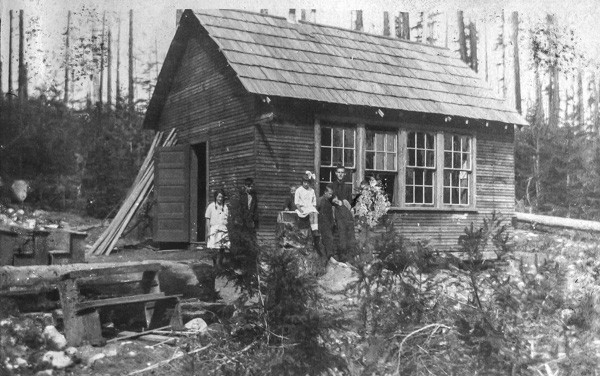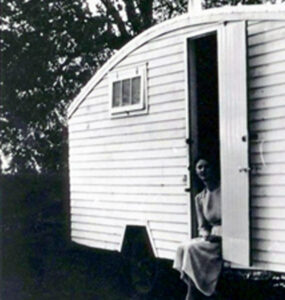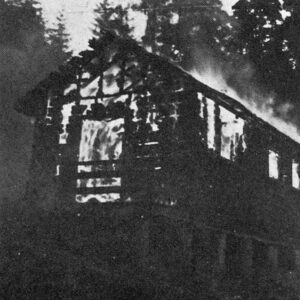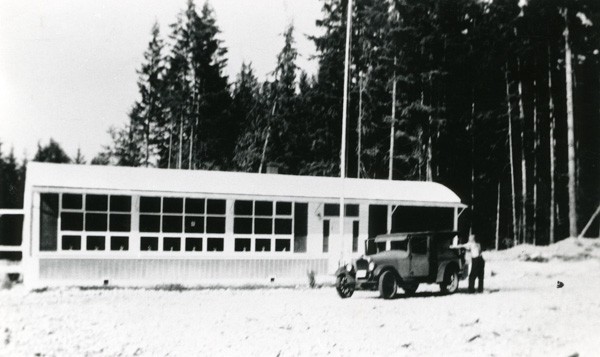At the beginning of the 1900s, Squirrel Cove on the east side of Cortes Island was a hub of activity for homesteaders, loggers, fishermen, miners and trappers. They came from all the surrounding islands for supplies, groceries, mail, repairs, radios and dances in the hall. There were two stores, a post office, church, hall, two machine shops, a boatworks, a marine ways, and a big dock where the Union Steamships stopped regularly. Jim Spilsbury also stopped frequently to install or repair his radios in boats and homes.

The first school classes were overseen by parents and held in a little one-room tar-paper shack right behind the store that still exists today. The first registered Squirrel Cove School was located at the top of the hill going west towards Gorge Harbour. It was a one-room school built in 1916 by locals and was used until 1941. Back in those days, a school needed 9 students for the government to supply a teacher. Residents of Whaletown and Squirrel Cove disagreed over which school was closest to Barret’s Lake (now called Blue Jay Lake) in Green Valley where a number of children lived. Bill Barrett settled the debate by tying a rag to a wheel on his wagon and counting the revolutions on a trip from Green Valley to each school. Squirrel Cove won, so the Green Valley children walked there. The nearby Seaford community had a school that opened in 1921 for only ten years. When it closed in 1931, children from there joined the Squirrel Cove School. The school had just one small room with a tiny cloakroom at one end. There were no washrooms, just outhouses up on the hillside.
No First Nation children attended school here. In centuries past the Salish Klahoose used Squirrel Cove traditionally for harvesting and fishing. Near the end of the 1800s, they moved permanently to Squirrel Cove. After 1915 Klahoose children were taken to Residential School in Sechelt by Union Steamships, returning home for Christmas, Easter and summer holidays. Fred Reedel remembers in the 1940s, “Even though we didn’t go to school together, we all played together.”

After 1941 students attended school in the Columbia Coast Mission Church on the hill behind the Squirrel Cove store. It was a challenging post for a teacher. The children were independent, capable, resourceful, and played outrageous tricks at school.
One day at lunchtime Fred Reedel and his buddies, Bernie Layton and Carl Tander, climbed up on the steep shake roof using an old ladder that was there. The young female teacher heard them up on the roof and came outside, telling the boys to get down. They refused, so she climbed the ladder – in her long skirt and high heels! The boys went over the top of the roof to entice her over. Once the teacher was straddling the peak, the three boys quickly scrambled back over the peak and down the ladder – then removed it! Doug Forrest was working on his wharf not far away and heard the teacher screaming and yelling. He came over and wondered “What in blue heaven are you doing up there?” He scolded her for being on the roof, retrieved the ladder, and helped her down. Meanwhile, the three amigos were hiding in the bushes and thought they were really “going to get it!” Fred never said what happened to them.
After the Second World War in 1946, Ron Forrest remembers logger Stan Anderson bulldozed the school grounds to smoothe it and kids could then all play ball together. “It had been hard for sports because of big rocks in the field so the ball would bounce off them like a Mexican jumping bean. We had a good time.” Ball games always included Klahoose kids from their village on the cove.

The Columbia Coast Mission Church/School burned down in 1947. Fred Reedel remembers that searing day well. It was lunchtime and most of the students were outside playing. Teacher Miss Ornton was trying to light a Coleman camp stove in the cloakroom to make tea. As she pumped up the gas, she didn’t realize the tank had a tiny hole and was spraying Naphtha gas onto the wallpaper. As she struck a match – BOOM! – and the walls caught fire. Miss Ornton let out a blood-curdling scream and flapped at the flames with a small coat. If she had grabbed a big coat she might have been able to smother it. Outside, Fred saw the flames going up the wall and across the ceiling. He noticed all their sports equipment just inside the door. Fred thought, “I’ve gotta save all that stuff – we cannot have things to play with!” So he dove under the coats and threw everything outside. “Everyone started running hither and yon to grab all their coats and personal stuff. The teacher sent one of the students to fetch Doug Forrest while everyone else stood back and watched – nothing to do, no water, not even a rain barrel. It took about twenty minutes to become ashes.”
Fred recalls students had a couple of days off until the School Board brought in more desks. At this time the nearby Squirrel Cove community hall was upgraded to double as school number four. “Gas lamps had to be supplied – you couldn’t see a thing because there were only a few small windows and the ceiling was open to the roof beams. It was very black – like going into a barn.”

This arrangement at the community hall stretched into three years until 1950 when a Quonset hut was built during the winter of 1949. As a teenager, Fred Reedel worked there when the Quonset hut, school number five, was built up the hill going south toward Manson’s Landing. “Oh God, that was a cold winter! We had about three feet of snow and then it blew wind for two or three weeks and it was cold.” Young Fred was hired to keep the fires roaring in five drums under a big tent so the workers making concrete foundations could warm up. They were working in the snow and blowing wind, and had those “fuzzy monkey-face” gloves that kept getting wet. The workmen would drape their gloves over the rim of the drums to dry, but when they came back later, there were no gloves, just the wristbands lying on the ground. Fred said, “When the school finally opened in the spring, there were all these darned wristbands – hundreds of ’em – all over the schoolyard. They sure as heck went through a pile of gloves!”
A new well was also dug. It was about 35 feet deep. After this new school opened for grades one to eight, the School Board wanted a water sample from the well. Teacher Don McDevitt collected a sample in a jar and sent three boys to deliver it to the postmaster down the hill for mailing. Fred recalls, “There was myself, Evan Burnett and Danny Hartman – we were the three rotten eggs – the oldest there then, in grade eight. So Danny says, “Let’s pee in it,” and we all did! Well, a few days later back comes a letter saying to close that well, lock it, and do not use the water under any circumstances. The well never did open again. They used it for flushing toilets, that’s all. We had to pack in drinking water.”

To attend high school, the Squirrel Cove students were bussed to Manson’s Landing starting about 1948. The “bus” driver was Ernie Guthrie, using his truck with an open back and hay bales for students to sit upon. Eventually, in 1954 the last Squirrel Cove School was permanently closed and then all the students were bussed to Manson’s Landing. The Quonset hut sat empty for years until it was sold in 1969 to dairy farmers Ken and Hazel Hansen who turned it into a cookhouse for their summertime Lakeview Guest Ranch. The Hansens sold the ranch in 1979 and it became Linnaea Farm, with the Quonset hut reinvented as a schoolhouse, and used for many years by the Linnaea Alternate School until 2010 when it closed. Today (2017) it is in use as part of the Linnaea Farm Education Centre.
This blog was first published in the 2018 spring issue of the British Columbia History magazine published by the British Columbia Historical Federation, https://www.bchistory.ca/british-columbia-history-spring-2018-sneak-peek/. Issue 51.1 — “Stories of Schools in BC” — includes 11 feature articles celebrating schools and school experiences in Bloedel, Clinton, Cortes Island, Cranbrook, Duncan, Gray Creek, Kimberley, Nanaimo, Surrey, Vancouver, Victoria and more.


